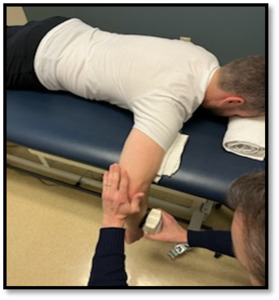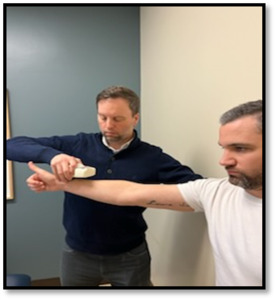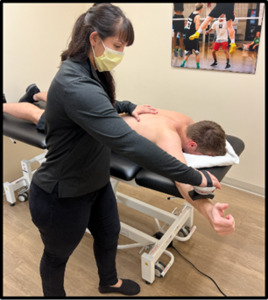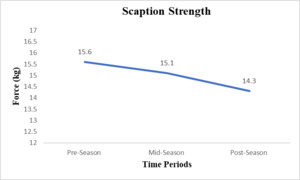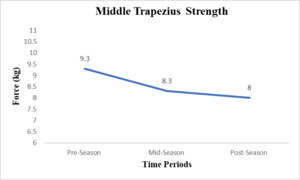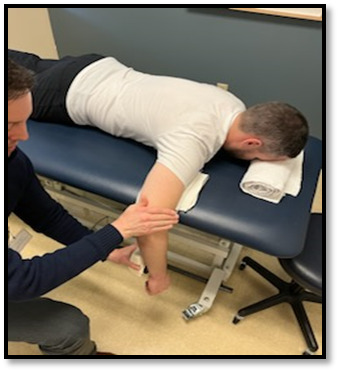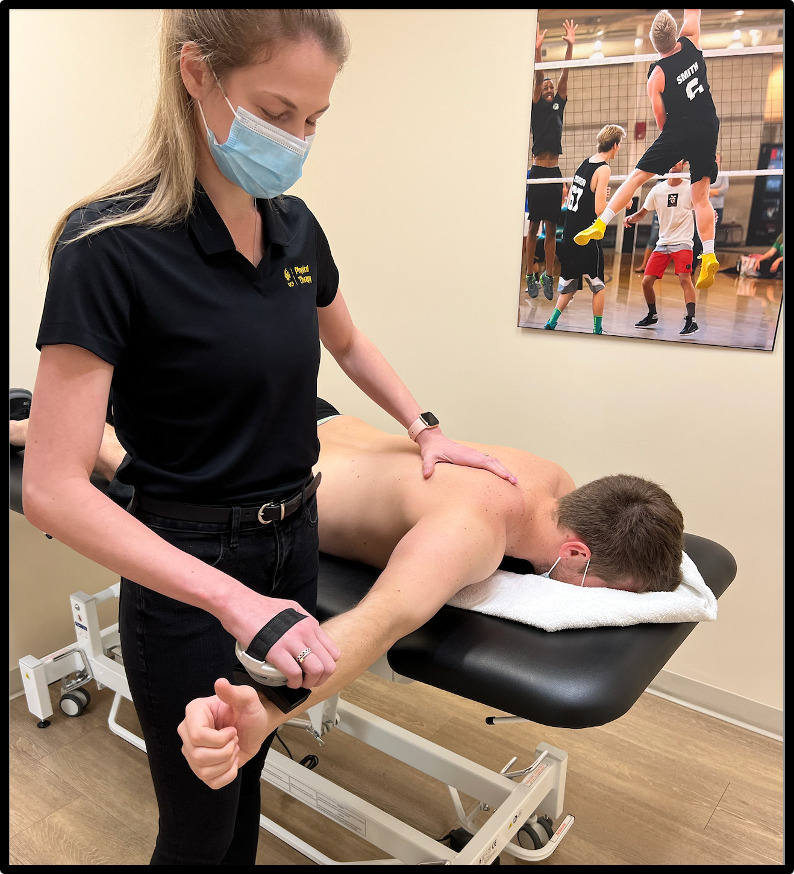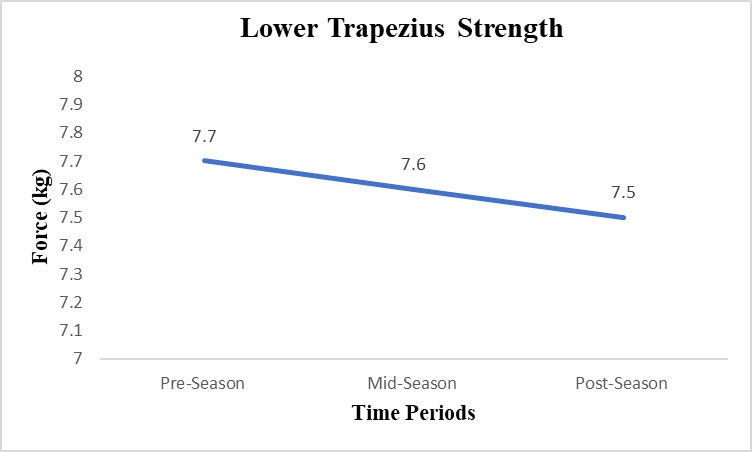INTRODUCTION
The baseball pitching motion is a complex and repetitive movement that requires a combination of precision and high velocity, where shoulder peak angular velocities can reach up to 7000°/sec.1–6 This velocity leads to several substantial forces acting on the shoulder including distraction forces of up to 950 N at ball release and compression forces of up to 1090 N.4 Additionally, shear forces of 310 N and 250 N can occur at the anterior and superior glenohumeral joint surfaces respectively.4 The rotator cuff is highly involved in the generation, control, and dissipation of these forces. In addition, scapular muscles are highly active during the arm cocking, acceleration and deceleration phases due to their role in scapular and glenoid positioning during the dynamic and rapid arm motion of throwing.7 Given the repetitive application of these forces to the shoulder and scapular musculature over the course of a collegiate baseball season, there is potential for changes in shoulder and scapular strength during the season.
Weakness in the shoulder musculature, specifically the rotator cuff, has been proposed as a risk factor for developing a shoulder injury in baseball pitchers.8–12 Several authors have reported that more than 57% of baseball pitchers suffer a shoulder injury during a playing season, including but not limited to rotator cuff tears and/or tendinitis, glenohumeral labral degenerations and tears, secondary subacromial impingement syndrome (SIS), as well as microtrauma to both the static and dynamic stabilizers of the shoulder and elbow.9,13,14 Of further concern is that currently there is no consensus on an optimal in season program for mitigation of strength loss. Therefore, understanding the temporal shoulder and scapular strength characteristics of pitchers can assist in the guidance of targeted treatment strategies and rehabilitation protocols.
To this end, muscle strength profiles of the rotator cuff and scapular musculature in asymptomatic high school, collegiate, and professional pitchers at singular points in time have been established.9–11,15–21 This information has helped guide general interventions aimed at addressing shoulder and scapular muscle weakness, improving performance, and mitigating injury risk. Further research has detailed the changes in shoulder muscle strength profiles after acute bouts of single session throwing in collegiate level pitchers. Gagnon et al.22 found no changes in external and internal rotation strength while Mirabito et al.23 found a reduction in external rotation strength. Mullaney et al.19 found minimal changes in scapular stabilizer strength and a gross reduction in shoulder strength with the exception of external rotation and strength in the empty can testing position. Strength profiles of high school and professional pitchers have also been established at preseason to preseason time points which illustrate that pitchers often enter a season with supraspinatus and external rotation weakness that is associated with an increased risk of injury to the shoulder.8,24 Further, Trakis et al.11 found that asymptomatic adolescent pitchers with a history of shoulder pain in the prior season had decreased middle trapezius strength compared to pitchers without a history of pain.
However, limited evidence exists on changes of both shoulder and scapular strength profiles during the course of a season in asymptomatic Division I collegiate baseball pitchers. Studies by McHugh et al.25 and Whitley et al.26 examined shoulder muscle strength changes from preseason to post-season in asymptomatic high school pitchers, with McHugh et al. including interscapular muscle strength assessment. Wilkin et al.27 examined isokinetic concentric shoulder rotator muscle changes, but not scapular muscle changes, in asymptomatic Division II collegiate pitchers at preseason, mid-season, and post-season. And finally, Sumimoto et al.28 examined preseason, mid-season and post-season scapular and shoulder strength changes in asymptomatic professional pitchers. Understanding strength profile changes at different levels of competition is important given the variation in pitching demands at each level. Fleisig et al.29 found that joint forces, torques and velocity specific measures increased at each progressive level of competition without position or temporal changes, suggesting kinetic differences were most likely due to greater muscle strength at each higher level.
Therefore, the purpose of this study was to investigate periscapular strength profiles of Division I collegiate baseball players over the course of a season. This study may assist in understanding normal strength profiles and muscular attrition over the course of a season in D1 collegiate pitchers and help guide rehabilitation professionals with targeted interventions to address anticipated loss of strength in specific muscles during specific in season timeframes. The authors hypothesized that shoulder scaption, internal rotation, external rotation, middle trapezius, and lower trapezius isometric strength values would decrease over the course of a season.
METHODS
Study Design
This study was a retrospective analysis of existing data that was used in a sports science initiative for injury monitoring and establishing baseline for injuries. Institutional review board approval for this study was obtained by the University of Central Florida.
Participants
The data from eighteen Division I male baseball pitchers was used in this study. Each subject was assessed for scaption, external rotator, internal rotator, middle trapezius and lower trapezius isometric strength on their throwing arm.
Assessment of Periscapular Strength
Muscular strength measurements were taken using the MicroFET 2 Wireless Handheld Dynamometer. The system is compact, portable and can measure up to 300 pounds (approximately 136 kilograms) of force. The intraclass correlation coefficient for the MicroFET 2 was measured in a previous study that examined the reliability of using the MicroFET 2 to measure the strength of the internal and external rotators of the shoulder in adolescent swimmers.30 The authors reported an ICC of more than 0.90 and a low percentage of method error variation, concluding that the MicroFET 2 was a reliable measure of internal and external rotation strength in swimmers.30 Furthermore, MicroFET 2 ICCs of .94 for external rotation and .93 for internal rotation have been reported in the measurement of shoulder rotator strength in competitive high school and collegiate baseball athletes.31,32
Data Collection Procedures
The data for each subject was recorded at three time points throughout the baseball season. Data collection sessions transpired on a single day during the pre-season, mid-season and immediately post-season, with a total duration of collection being a five-month period. Three trials of each strength measure were taken at each session by the same rater who is a board-certified clinical specialist in sports, with experience in use of the hand-held dynamometer. An average strength measurement for each position was calculated. Strength measures in kilograms were recorded for five different muscle groups: shoulder scaption, shoulder external rotators, shoulder internal rotators, middle trapezius, and the lower trapezius. Each test consisted of the subject contracting against a maximal force applied by the tester. The maximal force was applied until the participant broke from the test position.33 The force required to break the test position was recorded as the relative strength of the muscle group being measured. Prior studies assessing shoulder and scapular muscle strength in collegiate and professional baseball players have utilized a break test,19,31,34 which has also been shown to be correlated to the forces produced during make tests.35
Shoulder internal and external rotator strength was measured with the participant prone with their shoulder abducted to 90 degrees and their elbow flexed to 90 degrees. Positioning the patients in prone with the arm abducted to 90 degrees replicates the functional throwing position of the glenohumeral joint and has been utilized in several studies involving high school, collegiate, and professional baseball pitchers and players.8,36,37
For internal rotator strength assessment, the digital dynamometer was placed on the volar aspect of the distal forearm and the test was performed. (Figure 1)
For external rotator strength assessment, the digital dynamometer was placed on the dorsal aspect of the distal forearm and the test was performed. (Figure 2)
Scaption strength was measured with the participant in standing, with their arm flexed to 90 degrees and horizontally abducted to be in line with the scapular plane. The digital dynamometer was placed over the distal radius with the thumb pointed towards the sky and the test was performed. (Figure 3)
Middle trapezius strength was measured with the participant prone with their shoulder abducted to 90 degrees, the elbow fully extended, and the forearm supinated so the thumb was pointed to the sky. This position biases the middle trapezius muscle fibers.33 The dynamometer was again placed at the distal radius and the test was performed. (Figure 4)
Lower trapezius strength was measured with the participant prone with their shoulder abducted to 120 degrees, the elbow fully extended, and the forearm supinated so the thumb was pointed to the sky. This position biases the lower trapezius muscle fibers.33 The dynamometer was again placed at the distal radius and the test was performed. (Figure 5)
Statistical Analyses
Descriptive statistics were calculated for each muscle group to determine a strength profile in this population during each time period. Mean scores in kilograms (kg) were calculated across three trials for each time period. Percent changes in strength were also calculated to identify changes in first and second halves of the season. This was done by kg loss or gain divided by pre-season mean score for first half percent change and kg loss or gain divided by mid-season mean score for second half of the season. Intraclass correlation coefficients (ICCs) were calculated for each muscle group to determine the intra-rater reliability of the MicroFET 2 in the collegiate baseball pitcher population for each of the muscle groups across the prescribed testing positions. A repeated measure analysis of variance (ANOVA) (IBM SPSS Statistics 28.0) was used to determine if a change in muscle strength occurred over the course of the baseball season, from pre-season to mid-season, and immediately post-season. Post hoc Bonferroni assessments were conducted to examine pairwise differences between each data collection period. An alpha level of 0.05 was used to reject the null hypothesis. Effect sizes were reported as partial eta squared, which is the ratio of variance associated with an effect, plus that effect and its associated error variance. The formula is partial eta2 = sum of squares for the effect / sum of squares for the effect + sum of squares for the error. Values of 0.01, 0.06, and 0.14 were utilized to determine a small, medium, and large effect.
RESULTS
Descriptive statistics were calculated for each time period, with means and standard deviations for the strength measures identified in Table 1. Intraclass correlation coefficients (ICCs) were calculated for the three trials by the rater at each of the time points and were found to be strong. ICCs ranged from a low of 0.844 to a high of 0.971 (Table 2). Standard error of the mean (SEM) scores and Minimum Detectible Change (MDC) values were also calculated and included in Table 1. Sphericity was found for all measures, ranging from 0.2-0.702, which suggests equal variances in strength measures among time points.
Over the three time-points, all strength values decreased for each muscle group, but scaption was the only measure found to have a statistically significant decrease across the season (p = 0.018, F = 4.758; partial eta squared=0.284). Scaption decreased by 1.2 kg from pre-season to post-season, which exceeded the MDC value of 0.87kg for the measure. External rotator, internal rotator, middle trapezius, and lower trapezius strength values all decreased over the course of the season (range 0.02kg to 1.8kg). Although the strength differences were not statistically significant (p > 0.05), the middle trapezius strength value change (1.3kg loss) exceeded the MDC (Table 1).
Data points were further evaluated to examine strength changes not only from the pre-to post-season, but also in consideration of changes between pre- to mid-season and mid- to post-season. Strength values were standardized to consider overall percent strength changes during these time periods (Table 3). On average, the periscapular musculature strength loss was 4.22% in the first half of the season (range +0.4% to 10.75%) while the average loss was 2.97% in the second half of the season (range 1.32% to 7.73%). The middle trapezius lost the greatest amount of strength during the first half of the season (10.75%), followed by external rotation (5.85%), while the greatest strength losses in the second half of the season occurred in internal rotation (7.73%), followed by scaption (5.30%), and the middle trapezius (3.61%). Figures 6-10 graphically represent the individual muscle group changes from pre-season to mid-season to post-season.
Scaption strength decreased 8.3% overall through the season, with a 3.2% decline from pre-to mid-season, and another 5.3% decline occurring from mid-to post-season. External rotator strength decreased by 5.85% from pre-season to midseason and then increased by 3.1% from mid-season to post-season resulting in a 2.93% reduction in strength over the course of the entire season. Internal rotator strength decreased by 0.4% from pre-season to mid-season and then decreased by 7.73% from mid-season to post-season resulting in a 7.33% reduction in strength over the course of the entire season. Middle trapezius strength decreased by 10.75% from pre-season to mid-season and by 3.61% from mid-season to post-season with a 13.98% reduction in strength over the course of the entire season. Lower trapezius strength decreased by 1.30% from pre-season to mid-season and by 1.32% from mid-season to post-season with a 2.60% reduction in strength over the course of the entire playing season.
A post-hoc power analysis conducted utilizing the statistically significant finding of diminished scaption strength via the repeated measures ANOVA was conducted. Using the calculated partial eta squared (0.284), which equates to an effect size (f) of 0.623, and post-hoc power of 0.99. With this effect, follow-up studies would need a minimum of six subjects to obtain >.80 power, if utilizing this outcome variable (scaption strength). In observance of the lowest effect size, which was found in the middle trapezius assessment (partial eta squared 0.054), a total sample size of 30 subjects would be needed to achieve >.80 power in future studies using repeated measures.
DISCUSSION
The results of this study primarily supported the hypothesis that strength values of specific periscapular muscles would decrease over the course of the season. All strength measures demonstrated an overall reduction over the course of the season, although only scaption met the threshold for a statistically significant decrease. The effect size for this change in value (partial eta squared=0.284) identifies this as a large effect. Further, the mean score change of 1.2kg far exceeds the MDC value for the scaption strength measure (0.87kg), which further substantiates this finding. The only other mean strength value that exceeded its MDC value was for the middle trapezius (1.3kg mean score difference; MDC 0.78). Although this change was not statistically significant, such trend may warrant future investigation.
When considering overall strength loss, average percent loss across all muscle groups measured was similar when considering the first half of the season (4.22% loss) versus the second half of the season (2.97% loss). These findings are outlined in Table 3. Although average strength loss across muscle groups was fairly consistent, it should be noted that the middle trapezius lost the most strength during the course of the season (13.98% loss), with a majority of this loss transpiring over the first half of the season (10.75%). Similar to the middle trapezius, external rotation also had its greatest loss in the first half of the season (5.85% loss). While scaption had the second greatest loss in total strength (8.30% loss), most of this took place in the second half of the season (5.30% loss). In similar fashion, internal rotation strength had a more substantial loss during the second half of the season (7.73%). External rotation was the only measure in which strength increased during any point in the study time period (Table 3). This transpired when pitchers increased their strength by 3.1% during the second half of the season.
The authors believe that in-season training via the team’s structured strength and conditioning program could have created this change in external rotation strength as well as reduced the loss in middle trapezius strength, if these muscle groups were indeed a strong focus or perhaps extensive focus. The authors postulate that this effect could be contributing to this increase, or perhaps it could be related to a training effect from the strong eccentric demand placed on the external rotators during the pitching motion, coupled with the ability for eccentric activity to produce greater gains in strength compared to concentric training.38,39 Last, error in measurement as indicated by the larger standard deviation scores of internal and external rotation strength could be a factor related to this finding. Future studies examining the structure, prescription, and dosing of such strength and conditioning practices during the baseball season may be warranted.
The pre-season to post-season reduction in scaption strength in this study was supported by McHugh et al.,25 who examined strength adaptations in high school baseball pitchers over the course of a season. McHugh et al. reported significant supraspinatus strength reduction of 7% over the course of a season, with strength reductions of 13% in high volume pitchers, and nonsignificant strength reductions of 6% and 2% in moderate to low volume pitchers, respectively. While the present study did not dichotomize pitchers based on throwing volume, this concept may be warranted in future investigations with collegiate pitchers.
The current study results indicate that scaption strength was reduced over the course of the season by 8.3%. McHugh et al. also reported significant reductions over the course of the season in internal rotator strength (6%), external rotator strength (7%), and scapular retractor strength (4%). While the present study did not show statistically significant differences in all strength measure assessed, nonsignificant reductions of 2.93% external rotator strength, 7.33% reduction of internal rotator strength, 13.98% reduction of middle trapezius strength, and 2.60% reduction of lower trapezius strength did occur over the course of the season.
The pre-season to post-season changes in external rotator and internal rotator strength were not supported by those found by Wilkin et al.,27 which examined isokinetic external and internal rotator strength of Division II collegiate baseball pitchers during a season. Wilkin et al. reported no differences over time in isokinetic external or internal rotator mean peak torque values. Differences in results may be in part due to the method of testing, as isokinetic testing was utilized by Wilkin et al. and isometric testing was utilized in the current study.
Over the course of the competitive collegiate baseball season, periscapular strength values decreased. The authors hypothesize that this may be due to the shift in training that occurs as part of a typical periodized training program, as pitchers transition from intense strength training in the pre-season to a maintenance program during the in-season to avoid fatigue and reduce the risk of injury.39,40 As a result, internal rotation and scaption strength were higher in the preseason and followed an anticipated decrease over the course of the season.
The significant loss of early season middle trapezius strength and full-season scaption strength in this study is concerning, especially as studies have also reported that pre-season supraspinatus weakness has been shown to be 12% lower in the dominant vs. nondominant arm in collegiate pitchers.19 Failure to gain supraspinatus strength from post-season to the following preseason may predispose the pitcher to injury, given the rates of shoulder injury to pitchers during the season and the risk factors involved with pitching with fatigue. Further, the role of the lower and middle trapezius in scapular positioning and control during the pitching motion is well established relative to shoulder injury.41–43 These weaknesses suggest that careful attention should be placed on the development of the periodized periscapular strength training program to account for in-season periscapular strength changes and the need to increase supraspinatus strength from post-season to the following pre-season.
This study has several limitations. The weight of each athlete was not recorded. As a result, all strength values are reported as absolute values and not recorded relative to body weight. The sample size was small and all pitchers were from the same university and participating in the same strength training protocols. As this was a retrospective data analysis, data that was analyzed did not include information regarding specifics in the periodized strength training regimen and therefore it is uncertain what effect, if any, the periodized strength training regimen had on the seasonal strength changes. Further, pitchers’ level of participation and throwing volume throughout the season were not recorded. Each of these limitations offers opportunities for future investigation. Last, the empty can test position was not utilized as it had been used in previous studies for assessment of supraspinatus strength in baseball pitchers.11,18,19,24 Therefore, results of scaption strength may not fully represent supraspinatus strength measures as measured in other studies.
CONCLUSION
Strength of the rotator cuff and other periscapular musculature experienced normal attrition of strength by approximately 3-14% over the course of a season in Division I collegiate baseball pitchers, however only scaption strength decreased significantly. Although periscapular musculature lost nearly the same amount of strength in the first and second halves of the season, individual muscle groups lost strength at different time periods, with middle trapezius diminishing most during in the first half of the season, while internal rotators and scaption lost the most strength at the second half of the season. While differences in fatigue patterns may occur due to specific muscular actions during pitching, throwing volume, or mitigation effects of in-season training, future investigations are warranted. Understanding normal strength values as well as the strength changes of the shoulder girdle musculature in throwing athletes may assist various rehabilitation professionals, strength and conditioning professionals, and sports physical therapists in the appropriate targeting of metrics for training and therapeutic interventions for the baseball pitchers.
Conflict of Interest
The authors have no conflict of interest to report.

